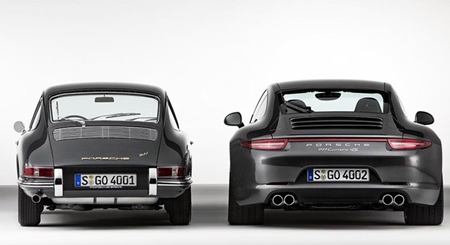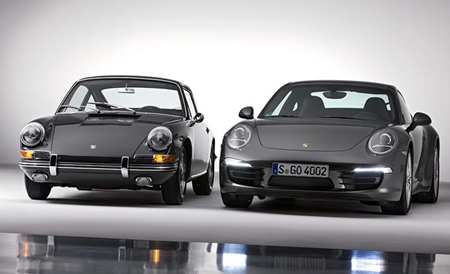The iconic Porsche 911 reaches its half century this year, and courtesy of the Porsche factory, here is the legend from the start through to today:
The Initial 911 (1963)
Successor to the Porsche 356, the 911 prototype was first unveiled at the Frankfurt IAA Motor Show in 1963 as the 901, and renamed the 911 for its market launch in 1964 (as Peugeot had taken all three digit numbers with a zero in the middle). Its air-cooled six-cylinder boxer engine delivered 130 hp, giving it an impressive top speed of 210 km/h.
Starting in 1965 you could also opt for the four-cylinder Porsche 912. In 1966 Porsche presented the 160 hp 911 S, which was the first to feature forged alloy wheels from Fuchs. The 911 Targa, with its distinctive stainless steel roll bar, made its debut in late 1966 as the world’s first ever safety cabriolet. The semiautomatic Sportomatic four-speed transmission joined the lineup in 1967. With the 911T of the same year, and the later E and S variants, Porsche became the first German manufacturer to comply with strict US exhaust emission control regulations.
 Porsche rear view for 50 years.
Porsche rear view for 50 years.
The Porsche 911 became more and more powerful as displacement increased, initially to 2.2 liters (1969) and later to 2.4 (1971). The 911 Carrera RS 2.7 of 1972 with 210 hp engine and weighing less than 1000 kg remains the epitome of a dream car to this day. Its characteristic “ducktail” was the world’s first rear spoiler on a production vehicle (and my personal favorite).
The G-Series (1973) – The Second Generation
The G model was produced from 1973 to 1989, longer than any other 911 generation. It featured prominent bellows bumpers, an innovation designed to meet the latest crash test standards in the United States. One of the most important milestones was the 1974 unveiling of the first Porsche 911 Turbo with a three-liter 260 hp engine and enormous “whale tail”.
 Either of them will do!
Either of them will do!
The next performance jump came in 1977 with the intercooler-equipped 911 Turbo 3.3. At 300 hp it was the best in its class. In 1983 the naturally aspirated 911 Carrera superseded the SC; with a 3.2 liter 231 hp engine. Starting in 1982, the 911 Cabriolet was available. The 911 Carrera Speedster, launched in 1989, was evocative of the legendary 356 of the fifties.
The 964 (1988) – Classic Modern
In 1988 Porsche came out with the 911 Carrera 4 (964). The 911 platform was radically renewed with 85 percent new components. Its air-cooled 3.6 liter boxer engine delivered 250 hp. Externally, the 964 differed from its predecessors only slightly, in its aerodynamic polyurethane bumpers and automatically extending rear spoiler, but internally it was almost completely different. It came with ABS, Tiptronic, power steering, and airbags, and rode on a completely redesigned chassis with light alloy control arms and coil springs instead of the previous torsion-bar suspension. A revolutionary member of the new 911 line right from the start was the all-wheel drive Carrera 4 model. In addition to Carrera Coupé, Cabriolet and Targa versions, starting in 1990 customers could also order the 964 Turbo. Initially powered by the proven 3.3 liter boxer engine, in 1992 the Turbo was upgraded to a more powerful 360 hp 3.6 liter power plant.
The 993 (1993) – The Last Air-Cooled Models
The 911 with the internal design number 993 remains the one true love of many a Porsche driver. The integrated bumpers underscore the smooth elegance of its styling. The front section is lower-slung than on the earlier models, made possible by a switch from round to poly-ellipsoid headlights. The 993 was also agile with a newly designed aluminium chassis. The Turbo version was the first to have a bi-turbo engine, giving it the lowest-emission stock automotive powertrain in the world in 1995. The hollow-spoke aluminium wheels were yet another innovation of the all-wheel drive Turbo version. The Porsche 911 GT2 was aimed at the sports car purist. An electric glass roof that slid under the rear window was one of the innovations of the 911 Targa. But the real reason dyed-in-the-wool Porsche enthusiasts still revere the 993 is that this model, produced from 1993 to 1998, was the last 911 with an air-cooled engine.
The 996 (1997) – Water-Cooled
The 996, which rolled off the assembly line from 1997 to 2005, represented a major turning point in the history of the 911. It retained all the character of its classic heritage, but was an entirely new automobile. This comprehensively redesigned generation was the first to be driven by a water-cooled boxer engine. Thanks to its four-valve cylinder heads it achieved 300 hp and broke new ground in terms of reduced emissions, noise, and fuel consumption. The exterior design was a reinterpretation of the 911’s classic line, but with a lower drag coefficient (cW) of 0.30. The lines of the 996 were also a result of component sharing with Porsche’s successful Boxster model. Its most obvious exterior feature were the headlights with integrated turn signals, at first controversial but later copied by many other manufacturers. On the inside, drivers experienced an entirely new cockpit. Driving comfort now also played a greater role alongside the typical sporty characteristics. With the 996 Porsche launched an unprecedented product offensive with a whole series of new variations. The 911 GT3 became one of the highlights of the model range in 1999, keeping the tradition of the Carrera RS alive. The 911 GT2, the first car equipped with ceramic brakes as standard, was marketed as an extreme sports vehicle starting in the fall of 2000.
The 997 (2004) – Classicism and Modernity
In July 2004 Porsche unveiled the new generation 911 Carrera and 911 Carrera S models, referred to internally as the 997. The clear oval headlights with separate blinkers in the front apron were a visual return to older 911 models, but the 997 offered more than just style. It was a high-performance vehicle, with a 3.6 liter boxer engine that turned out 325 hp while the new 3.8 liter engine of the Carrera S managed an incredible 355 hp. The chassis was also substantially reworked, and the Carrera S came with Porsche Active Suspension Management as standard equipment. In 2006 Porsche introduced the 911 Turbo, the first gasoline-powered production automobile to include a turbocharger with variable turbine geometry. A model update in the fall of 2008 made the 997 even more efficient thanks to direct fuel injection and a dual clutch transmission. Never before had the 911 series made such extensive allowances to suit drivers’ individual preferences, and with Carrera, Targa, Cabriolet, rear or all-wheel drive, Turbo, GTS, special models, and road versions of GT racing cars, the 911 family ultimately comprised 24 model versions.
The 991 (2011 through to today) – Refined by Experience
This car, known internally as the 991, represents the greatest technical leap in the evolution of the 911. Already the class benchmark for decades, the new 911 generation raised performance and efficiency to new levels. A totally new suspension with a longer wheelbase, wider track, larger tyres and an ergonomically optimized interior – it all adds up to an even sportier yet more comfortable driving experience. Technically, the 911 is the epitome of Porsche Intelligent Performance – even lower fuel consumption, even higher performance. This is due in part to the smaller 3.4 liter displacement in the Carrera basic model (yet developing 5 hp more than the 997/II), and to its hybrid steel/aluminium construction, which significantly reduces curb weight. Other innovations include Porsche Dynamic Chassis Control (PDCC) and the world’s first seven-gear manual transmission. The design of the 991 has likewise met with high critical acclaim. With its flat, stretched silhouette, exciting contours, and precisely designed details, the seventh generation of the Porsche 911 Carrera remains unmistakably a 911 that has once again succeeded in redefining the standard for automobile design. It is the best 911 of all time – until the next generation.
The above is for all Porsche enthusiasts, and there are many in Thailand.




